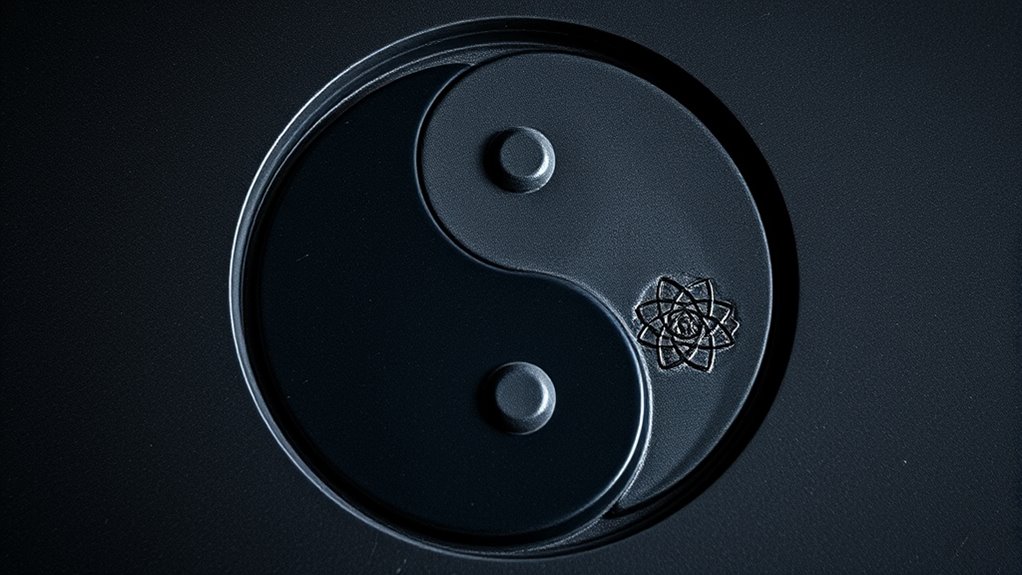The yin-yang symbol encodes more than simple opposites; it reveals a hidden geometry that emphasizes balance, flow, and interconnectedness. Its swirling, spiral-like curves symbolize continuous movement and harmony, reflecting how natural systems maintain order amid chaos. Small dots within the shape show how chaos and order coexist, shaping a unified whole. By exploring this deeper structure, you’ll see how the symbol embodies dynamic duality and universal unity—if you keep exploring, you’ll uncover more fascinating insights.
Key Takeaways
- The Yin-Yang symbol encodes continuous movement and balance through swirling, spiral-like shapes that reflect natural, dynamic flows.
- Its design reveals the interconnectedness of opposites, illustrating that dualities are facets of a unified, harmonious system.
- The small dots within each side represent coexistence of chaos and order, emphasizing the hidden geometry of interdependent forces.
- The flowing curves symbolize life’s interconnected web, illustrating how balance is maintained through ongoing, fluid interactions.
- The symbol’s geometry embodies the fundamental principles of harmony, illustrating that duality fosters potential and necessary balance.

Many people see Yin and Yang as simple opposites, but this ancient concept goes far beyond duality. Instead of just contrasting forces, Yin and Yang represent a dynamic interplay that embodies balance, harmony, and interconnected unity. When you look at the symbol, you’re not just seeing black and white; you’re glimpsing a visual language that encodes the fundamental nature of reality. The swirling shape reminds you that everything is in motion, constantly shifting between states, yet always maintaining a sense of equilibrium. This balance isn’t static—it’s a continuous dance, where each side contains a seed of the other, signaling a profound interconnectedness.
You can think of Yin and Yang as a reflection of how everything in the universe is interconnected. No force exists in isolation; every element is part of a larger whole, contributing to the ongoing dance of harmony. The small dots of opposite color within each side of the symbol serve as a reminder that within chaos, there’s always a touch of order, and within order, a hint of chaos. This interconnected unity suggests that opposing forces aren’t separate entities but facets of a unified system. When you understand this, you see that harmony arises not from eliminating differences but from embracing their relationship. Yin isn’t just darkness or passivity; it contains the potential for growth and change. Yang isn’t just brightness or activity; it carries the seed of rest and reflection. Both are necessary for the cosmic balance that sustains life and consciousness.
The symbol’s geometry also reveals how this balance is achieved through elegant, flowing curves that mimic natural forms. The spiral-like shape guides your eye in a continuous loop, emphasizing that harmony isn’t a fixed point but an ongoing process. This visual flow encourages you to see life as an interconnected web where each strand influences the others, creating a unified whole. The hidden geometry within the Yin-Yang symbol isn’t merely decorative; it encodes a deeper understanding of how the universe maintains order amid chaos. Recognizing this can help you see your own life in terms of balance and harmony, understanding that each moment, each emotion, or each challenge is part of a greater interconnected unity. When you grasp this, you realize that harmony isn’t about perfect order but about fluid, adaptable balance, where opposing forces work together to sustain the ongoing flow of life. Additionally, the concept of ethical hacking illustrates how proactive measures are essential to maintaining system integrity amidst potential vulnerabilities, much like how Yin and Yang balance opposing energies to sustain harmony.
Frequently Asked Questions
How Does the Yin-Yang Symbol Relate to Modern Physics?
You might see the yin-yang symbol as just a traditional icon, but it also relates to modern physics through quantum duality and spacetime symmetry. Just as yin and yang represent complementary forces, quantum duality shows particles behave like waves or particles depending on observation. Similarly, spacetime symmetry reflects balance in the universe. The symbol embodies this interconnectedness, illustrating how contrasting elements unify in nature’s fundamental structure.
Can Yin-Yang Principles Be Applied to Personal Development?
Like a skilled gardener tending to a delicate plant, you can apply yin-yang principles to your personal development. Embrace balance and harmony, recognizing that growth often requires both action and patience. By understanding dualities within yourself, you facilitate transformation, turning challenges into opportunities. This approach nurtures your inner harmony, helping you evolve steadily and resiliently, much like nature’s cycles, guiding you toward a more fulfilled and balanced life.
What Are the Origins of the Yin-Yang Symbol in Ancient Cultures?
You might wonder about the origins of the yin-yang symbol, which come from ancient philosophical ideas. Its roots trace back to Chinese culture, where it represented balance and harmony. Over time, this cultural symbolism evolved, reflecting deeper philosophical meanings. The symbol’s development shows how ancient cultures used simple imagery to express complex ideas about duality, unity, and the natural order.
How Does Yin-Yang Influence Contemporary Art and Design?
You see how yin-yang influences contemporary art and design by emphasizing balance and harmony. Artists and designers use contrast and unity to create visuals that evoke a sense of completeness and flow. This symbol inspires innovative patterns, color schemes, and compositions that reflect duality and interconnectedness, fostering a deeper understanding of life’s complexities. By incorporating these principles, modern works become more dynamic, meaningful, and visually compelling.
Are There Scientific Studies Supporting Yin-Yang’s Symbolic Meanings?
You might wonder if scientific studies support yin-yang’s symbolic meanings. Research indicates that concepts like quantum balance and neurological harmony align with yin-yang principles. For example, studies show how achieving balance in brain activity promotes well-being, paralleling yin-yang’s idea of harmony. While direct evidence is limited, these findings suggest a scientific basis for the symbolic importance of balance and duality, resonating with modern understandings of health and consciousness.
Conclusion
As you explore the hidden geometry behind Yin-Yang, you realize it’s more than just duality—it’s a dance of interconnected forces shaping your world. Like the ancient sages whispering secrets through symbols, you see that balance isn’t static but a dynamic flow, much like the moon’s gentle pull. Embracing this deeper harmony invites you to move beyond surface opposites, discovering the profound unity woven into the fabric of existence itself.










